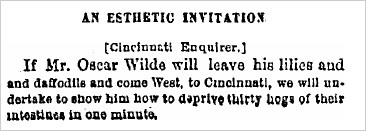Lecturing in the midwest
Oscar Wilde meets pioneers and native Americans
Above is Boyd’s Theatre and Opera House in Omaha, Nebraska, as it was when Oscar Wilde lectured there.
If the surroundings look a little unmade (and Oscar complained about Omaha’s muddy streets) it was to be expected—in 1882 the midwest of America was still a place of frontier development, something that the people of St. Paul ironically accepted:
By the time Wilde arrived in Omaha in March 1882, the geography of his American adventure had started to take shape.
After leaving the major East coast cities, Oscar made Chicago a hub with bookend lectures there first on February 13, and about a month later on March 11, making returning trips to the city during that period. The Chicago visits are significant in Wilde’s career as a lecturer, because each time he signaled a shift in his subject matter: first as the theme of The English Renaissance (see manuscript fragment) developed into The Decorative Arts; and on the second occasion debuting a new lecture, The House Beautiful, a topic he reserved for when he spoke more than once in the same city (see review of Wilde’s Lecture Titles).
In between the Chicago lectures, Wilde visited most of the other large midwest cities, such as St. Louis, but he also undertook a schedule of eleven consecutive days lecturing in eleven different smaller towns, such as Aurora, IL. This enabled him to not only experience places named for American pioneers such as Cleveland, Dubuque, and (Fort) Wayne, but also places with names of a more native origin such as Peoria, Milwaukee, and Sioux City. Oscar welcomed both cultures equally and warmly. He admired the sensible hats and clothing of the rugged westerners (see cartoon), and spoke of his interest in the prairie, buffaloes and elks, as well as the pleasure of speaking with native Americans, even being offered beaded slippers from an Indian who passed his window “decked out with feathers”.1
The welcome, however, was not always reciprocated: although the midwest itself was experiencing a growing acceptance of merging cultures, the agenda of an Oscar Wilde west was, for many, a little too much cultivation:

Around this time Wilde became annoyed because his current lecture was being advertised with an outdated title —and this, together with the smaller towns he was visiting, meant that audiences were much reduced.
He was also becoming physically tired. When he arrived in Racine on March 4, Wisconsin was the third state he had visited that week, and he broke down during the lecture before an unappreciative audience saying he was exhausted and unable to read his manuscript. It was probably this incident that prompted Wilde to write to his manager Col. W. F. Morse referring to the “fiasco of the last ten days” and pleading for a return to larger cities “instead of wearing my voice and body to death over wretched houses here.”2
Wilde was to get his wish and after Omaha he left the midwest on a four day train journey to California with, as he observed, “an Indian to disturb me at every comma3, and a grizzly at every semi-colon.”4
© John Cooper, 2015.
Footnotes:
- Complete Letters, 154. ↩︎
- Complete Letters, 146. ↩︎
- For more on Wilde and commas, see Took Out a Comma ↩︎
- Complete Letters, 141. ↩︎



I love this … we were in your town a few weeks ago on R&R. You ever feel as though your life is the reincarnation of some one else’s? Geeeez …
LikeLiked by 1 person
How about dates for the cuttings please?
LikeLike
Oscar Wilde
Pioneer Press (St. Paul), March 17, 1882
An Esthetic Invitation
Brooklyn Daily Eagle, January 22, 1882
Bernhardt
The Inter Ocean (Chicago), March 1, 1882, 8
LikeLike